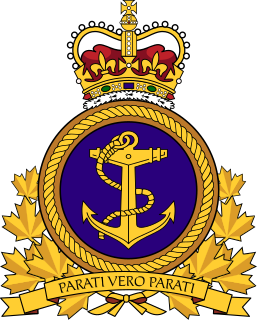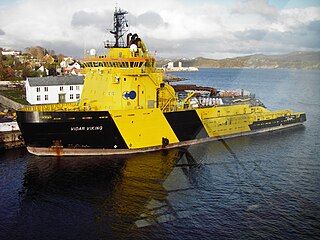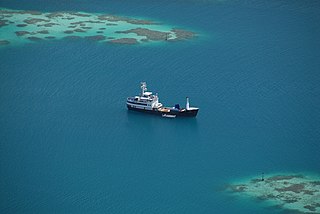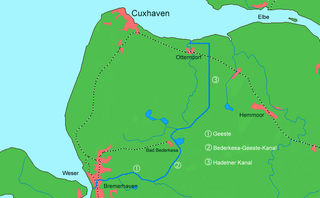
Maritime transport, fluvial transport, or more generally waterborne transport is the transport of people (passengers) or goods (cargo) via waterways. Freight transport by sea has been widely used throughout recorded history. The advent of aviation has diminished the importance of sea travel for passengers, though it is still popular for short trips and pleasure cruises. Transport by water is cheaper than transport by air, despite fluctuating exchange rates and a fee placed on top of freighting charges for carrier companies known as the currency adjustment factor (CAF).

The Royal Canadian Navy is the naval force of Canada. The RCN is one of three environmental commands within the unified Canadian Armed Forces. As of 2017, The Royal Canadian Navy operates 12 frigates, 4 patrol submarines, 12 coastal defence vessels and 8 unarmed patrol/training vessels, as well as several auxiliary vessels. The Royal Canadian Navy consists of 8,500 Regular Force and 5,100 Primary Reserve sailors, supported by 5,300 civilians. Vice-Admiral Art McDonald is the current Commander of the Royal Canadian Navy and Chief of the Naval Staff.

The United States Merchant Marine refers to either United States civilian mariners, or to U.S. civilian and federally owned merchant vessels. Both the civilian mariners and the merchant vessels are managed by a combination of the government and private sectors, and engage in commerce or transportation of goods and services in and out of the navigable waters of the United States. The Merchant Marine primarily transports cargo and passengers during peacetime; in times of war, the Merchant Marine can be an auxiliary to the United States Navy, and can be called upon to deliver military personnel and materiel for the military. Merchant Marine officers may also be commissioned as military officers by the Department of Defense. This is commonly achieved by commissioning unlimited tonnage Merchant Marine officers as Strategic Sealift Officers in the Naval Reserves.

The German Federal Coast Guard is a civilian law enforcement organisation whose primary missions are border protection, maritime environmental protection, shipping safety, fishery protection and customs enforcement. The Küstenwache is an association of several federal agencies, not a single entity like the United States Coast Guard.

Hyundai Glovis Co., Ltd. is a logistics company headquartered in Seoul, South Korea and part of the Hyundai Kia Automotive Group. Its predecessor company, Hankook Logitech Co. Ltd was formed in February 2001. Hyundai Glovis supplies ocean transportation logistics advice, cargo space, loading/unloading, and packaging services. It changed its name to Hyundai Glovis in June 2003.

The United States Merchant Marine Academy is a United States service academy in Kings Point, New York. It trains officers for the United States Merchant Marine, branches of the military, and the transportation industry. Midshipmen are trained in marine engineering, navigation, ship's administration, maritime law, personnel management, international law, customs, and many other subjects important to the task of running a large ship.

The Canadian Coast Guard is the coast guard of Canada. Formed in 1962, the coast guard is tasked with marine search and rescue, communication, navigation and transportation issues in Canadian waters, such as navigation aids and icebreaking, marine pollution response and providing support for other Canadian government initiatives. The coast guard operates 119 vessels of varying sizes and 22 helicopters, along with a variety of smaller craft. The CCG is headquartered in Ottawa, Ontario, and is a special operating agency within Fisheries and Oceans Canada.

The United States Maritime Administration (MARAD) is an agency of the United States Department of Transportation.
Its programs promote the use of waterborne transportation and its seamless integration with other segments of the transportation system, and the viability of the U.S. merchant marine. The Maritime Administration works in many areas involving ships and shipping, shipbuilding, port operations, vessel operations, national security, environment, and safety. The Maritime Administration is also charged with maintaining the health of the merchant marine, since commercial mariners, vessels, and intermodal facilities are vital for supporting national security, and so the agency provides support and information for current mariners, extensive support for educating future mariners, and programs to educate America's young people about the vital role the maritime industry plays in the lives of all Americans.

Kawasaki Kisen Kaisha, Ltd. is a Japanese transportation company. It owns a fleet that includes dry cargo ships, container ships, liquefied natural gas carriers, Ro-Ro ships, tankers and container terminals. It is the fourteenth largest container transportation and shipping company in the world.

Norddeutscher Lloyd (NDL) was a German shipping company. It was founded by Hermann Henrich Meier and Eduard Crüsemann in Bremen on 20 February 1857. It developed into one of the most important German shipping companies of the late 19th and early 20th centuries, and was instrumental in the economic development of Bremen and Bremerhaven. On 1 September 1970, the company merged with Hamburg America Line (HAPAG) to form Hapag-Lloyd AG.

Australian Maritime Safety Authority (AMSA) is an Australian statutory authority responsible for the regulation and safety oversight of Australia's shipping fleet and management of Australia's international maritime obligations. The authority has jurisdiction over Australia's exclusive economic zone which covers an area of 11,000,000 square kilometres (4,200,000 sq mi). AMSA maintains Australia's shipping registries: the general and the international shipping registers.

The German Maritime Museum is a museum in Bremerhaven, Germany. It is part of the Gottfried Wilhelm Leibniz Scientific Community. The main museum building was opened on 5 September 1975 by then-president of Germany Walter Scheel, though scientific work already had started in 1971. In 2000, celebrating the 25th anniversary of the museum, the Hansekogge, a ship constructed around 1380 that was found in the Weser river in 1962, was presented to the public after having undergone a lengthy process of conservation in a large preservative-filled basin.

USS Conecuh (AOR-110) was a fleet replenishment tanker, originally built by F. Schichau, Danzig, in 1938 as a combination oiler and supply vessel or "Troßschiff" for the Kriegsmarine and christened as Dithmarschen. Taken over by British authorities at Bremerhaven when World War II ended, Dithmarschen was allocated to the United States Navy on 15 January 1946 by the Inter-Allied Reparations Commission.

The Port of New York and New Jersey is the port district of the New York-Newark metropolitan area, encompassing the region within approximately a 25-mile (40 km) radius of the Statue of Liberty National Monument. It includes the system of navigable waterways in the New York–New Jersey Harbor Estuary, which runs along 650 miles (1,050 km) of shoreline in the vicinity of New York City and northeastern New Jersey, as well as the region's airports and supporting rail and roadway distribution networks. Considered one of the largest natural harbors in the world, the port is by tonnage the third largest in the United States and the busiest on the East Coast.
Sector Commander is the position title of the commanding officer of a United States Coast Guard Sector, usually of the rank of Captain (O-6). The Sector Commander's second-in-command is the Deputy Sector Commander. Also reporting directly to the Sector Commander are the Command Master Chief (CMC), the Senior Reserve Officer, and the Sector's Auxiliary Coordinator.
USS General W. G. Haan (AP-158) was a General G. O. Squier-class transport ship for the US Navy in World War II. She was named in honor of US Army Major General William G. Haan. She was transferred to the US Army as USAT General W. G. Haan in 1946. On 1 March 1950, she was transferred to the Military Sea Transportation Service (MSTS) as USNS General W. G. Haan (T-AP-158). She was later sold for commercial operation under several names before being scrapped in 1987.

CCGS Captain Molly Kool is a Canadian Coast Guard converted medium class icebreaker. She was originally built as an icebreaking anchor handling tug Vidar Viking for Trans Viking Icebreaking & Offshore AS in 2001. The vessel was acquired by the Canadian Coast Guard in August 2018 and was commissioned in May of the next year after refit.

YWAM Koha is a New Zealand-registered Medical Aid Ship, built in 1968 as the buoy tender Konrad Meisel for the German Government and later owned in South Africa as Isibane. As the Claymore II she provided the essential transport links to the remote Pacific territory of Pitcairn Island from New Zealand and French Polynesia, part-funded by the British Government until 2018 when she was replaced by the Silver Supporter.
NSW Maritime, the trading name of Maritime Authority of New South Wales, was an agency of the Government of New South Wales, Australia responsible for marine safety, regulation of commercial and recreational boating and oversight of port operations. The Authority had responsibility for marine incident investigation, including the causes of incidents involving shipping and commercial vessels and breaches of State or Commonwealth navigation laws. Incidents involving Sydney Ferries vessels are examined by the Office of Transport Safety Investigations, which is also responsible for investigations into incidents involving publicly owned rail and bus transport. The Authority was also responsible for property management of submerged lands in Sydney Harbour, Newcastle Harbour, Botany Bay and Port Kembla, and for providing strategic advice on ports and maritime matters to the NSW Government.

The Elbe–Weser waterway or Elbe–Weser shipping channel is a short-cut between the rivers Elbe and Weser in North Germany which is part-canal and part-river. It has a length of 54.7 kilometres (34.0 mi) and is designed for smaller coastal vessels. It includes some 60 kilometres (37 mi) of canal dykes and 45 kilometres (28 mi) of canal paths. The channel starts in Otterndorf with the Hadeln Canal, then becomes the Bederkesa-Geeste Canal from the town of Bad Bederkesa to the River Geeste, the final leg of the shipping channel, which flows into the Weser at Bremerhaven. It is owned by the state of Lower Saxony, maintained by the NLWKN from its Stade office. Today they just look after maintenance of the drainage system, because the economic element of the canal – commercial shipping which was particularly thriving in the late 1960s – declined increasingly from 1973 onwards and today hardly exists at all. Nevertheless the waterway is still used by smaller yachts as a short cut between Elbe and Weser.




















